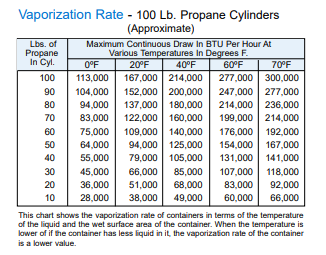mtholton
5 year old buck +
I've got a case of beer or two coming your way if you can help solve my riddle! Name your price!
We had a direct vent heater installed a little over a year ago (model below).
https://wildoaktrail.com/products/m...yyDh_WgROO6N1EY7Ars63aUqPCPKtA9saAqFMEALw_wcB
Worked good until we tried it for the first time this fall. We can get it going, but if we turn the dial up below the lowest setting, the flame dies out. We had the pressure tested and it was 11 w.c. and the manufacturer told me today it should be 14 at the inlet. The guy that did the testing on it stopped by when we weren't there and determined he didn't want to mess with it... I know nothing about this sort of thing and I've tried every hvac place within driving distance and I think everyone is too busy to want to take on a little project like this.
If I'm running propane from a 20lb tank, through a lp regulator, and its coming in at 11 w.. at the unit (which I understand to be a standard amount for a lp setup), how do I "turn it up" to 14 per the manufacture? Do they make adjustable regulators or am I thinking about this wrong? Again, it worked fine the year prior... We replaced the regulator to rule that out...
-----
Below is the troubleshooting the company suggested.
We are sorry for the inconvenience. See below for possible adjustments on the control valve. If the device still does not work after the settings, you will need to contact the installer so that he can send us the detailed report of the installation, basic tests carried out for the safety and proper functioning of the device, as well as the IN/OUT gas pressures of the control valve. Please also add your name, address, phone number and a copy of the invoice, and if you qualify for the warranty, we may send you the necessary spare part(s) if it is defective.
Troubleshooting for the MDV
The thermocouple must be checked with a standard voltmeter set to the “Ohms/Continuity” function to determine whether the probe circuit is open or not.
If the problem is related to a short rod between the control knob and the control valve, no replacement is available. However, we can recommend to insert a piece of aluminum foil (equivalent to 1-2 mm) into the control button to lift it, see the attached file "IMAGE A".
Screw #3: turn a quarter turn to the left to ensure burner flame stability.
Screw #6: Pressure should be between 13°W.C. and 14°W.C.
Screw #7: The pressure should be at 11°W.C., the adjustment is made using screw 2. Screw #6 should be adjusted before screw #7.
Screw #5: Adjust the driver to cover the thermocouple.
We had a direct vent heater installed a little over a year ago (model below).
https://wildoaktrail.com/products/m...yyDh_WgROO6N1EY7Ars63aUqPCPKtA9saAqFMEALw_wcB
Worked good until we tried it for the first time this fall. We can get it going, but if we turn the dial up below the lowest setting, the flame dies out. We had the pressure tested and it was 11 w.c. and the manufacturer told me today it should be 14 at the inlet. The guy that did the testing on it stopped by when we weren't there and determined he didn't want to mess with it... I know nothing about this sort of thing and I've tried every hvac place within driving distance and I think everyone is too busy to want to take on a little project like this.
If I'm running propane from a 20lb tank, through a lp regulator, and its coming in at 11 w.. at the unit (which I understand to be a standard amount for a lp setup), how do I "turn it up" to 14 per the manufacture? Do they make adjustable regulators or am I thinking about this wrong? Again, it worked fine the year prior... We replaced the regulator to rule that out...
-----
Below is the troubleshooting the company suggested.
We are sorry for the inconvenience. See below for possible adjustments on the control valve. If the device still does not work after the settings, you will need to contact the installer so that he can send us the detailed report of the installation, basic tests carried out for the safety and proper functioning of the device, as well as the IN/OUT gas pressures of the control valve. Please also add your name, address, phone number and a copy of the invoice, and if you qualify for the warranty, we may send you the necessary spare part(s) if it is defective.
Troubleshooting for the MDV
The thermocouple must be checked with a standard voltmeter set to the “Ohms/Continuity” function to determine whether the probe circuit is open or not.
If the problem is related to a short rod between the control knob and the control valve, no replacement is available. However, we can recommend to insert a piece of aluminum foil (equivalent to 1-2 mm) into the control button to lift it, see the attached file "IMAGE A".
Screw #3: turn a quarter turn to the left to ensure burner flame stability.
Screw #6: Pressure should be between 13°W.C. and 14°W.C.
Screw #7: The pressure should be at 11°W.C., the adjustment is made using screw 2. Screw #6 should be adjusted before screw #7.
Screw #5: Adjust the driver to cover the thermocouple.


